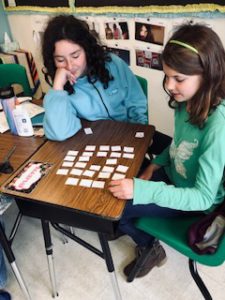La Lectura
Unit 5 Discoveries- The Big Idea: How can discoveries open new possibilities?
Weekly concept/Genre: Myths | Myths
Essential question: Why do we tell myths again and again? | Why do people tell and retell myths?
Objectives:
 Determine or clarify the meaning of unknown and multiple-meaning words and phrases based on grade 6 reading and content, choosing flexibly from a range of strategies.
Determine or clarify the meaning of unknown and multiple-meaning words and phrases based on grade 6 reading and content, choosing flexibly from a range of strategies. - Use common, grade-appropriate Greek or Latin affixes and roots as clues to the meaning of a word (eg, audience, auditory, audible).
- Consult reference materials (eg, dictionaries, glossaries, thesauruses), both print and digital, to find the pronunciation of a word or determine or clarify its precise meaning or its part of speech.
- Use the relationship between particular words (eg, cause / effect, part / whole, item / category) to better understand each of the words.
- Cite textual evidence to support analysis of what the text says explicitly as well as inferences drawn from the text.
- Compare and contrast texts in different forms or genres (eg, stories and poems; historical novels and fantasy stories) in terms of their approaches to similar themes and topics.
- Pose and respond to specific questions with elaboration and detail by making comments that contribute to the topic, text, or issue under discussion.
- Interpret information presented in diverse media and formats (eg, visually, quantitatively, orally) and explain how it contributes to a topic, text, or issue under study.
- Develop the topic with relevant, well-chosen facts, definitions, concrete details, quotations, or other information and examples.
- Establish and maintain a formal style and objective tone.
- Use technology, including the Internet, to produce and publish writing and present the relationships between information and ideas clearly and efficiently.
Ciencias
Students put eight letter tiles in cups to simulate the four-gene genotype of larkeys. After preparing a female larkey genotype and a male larkey genotype, they breed the pair by drawing one allele for each gene from each parent. The combination of eight random alleles is the genotype of the F 1 offspring. After breeding two F 1 offspring, one male and one female, students will decode the genotype to see what traits both offspring have. The key words for science this week were: homocigotico y heterocigotico. Ask your child to tell you about this.
Mathematics
This week we learned about the Coordinate Plane. We learned
- How to find the lengths of line segments
- Real world problems with line segments
- Using graphing to solve real world problems
(Written by: Juliette)
History & Geography
This week we learned about the Industrial Revolution
- We learned about the cotton gin, the Spinning Jenny and the flying shuttle.
- We learned about the constant variations in population.
- The population went down when there were wars, plagues, and poor sanitation.
- The population went up when factories produced more food for a lower price.
- The company owners were greedy, so they kept the machinery secret.
(Written by: Evan)
English Writing & Spelling
In writing this week we
- Shared argumentative writing
- Brainstormed ideas for Informative writing
- Did research and took notes for our writing.
In Greek and Latin Roots this week we
- Did our packets and posters about -Deci, -Cent, -Non
(Written by:Tamra)
